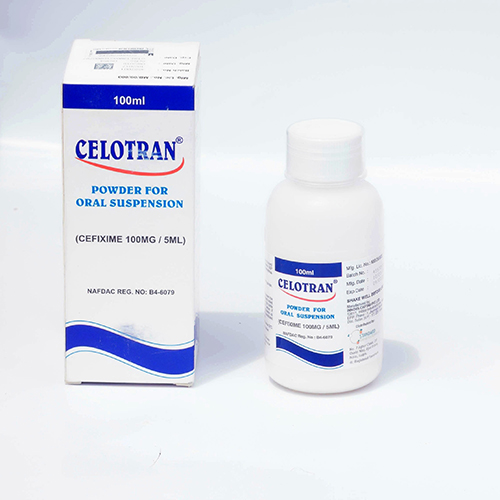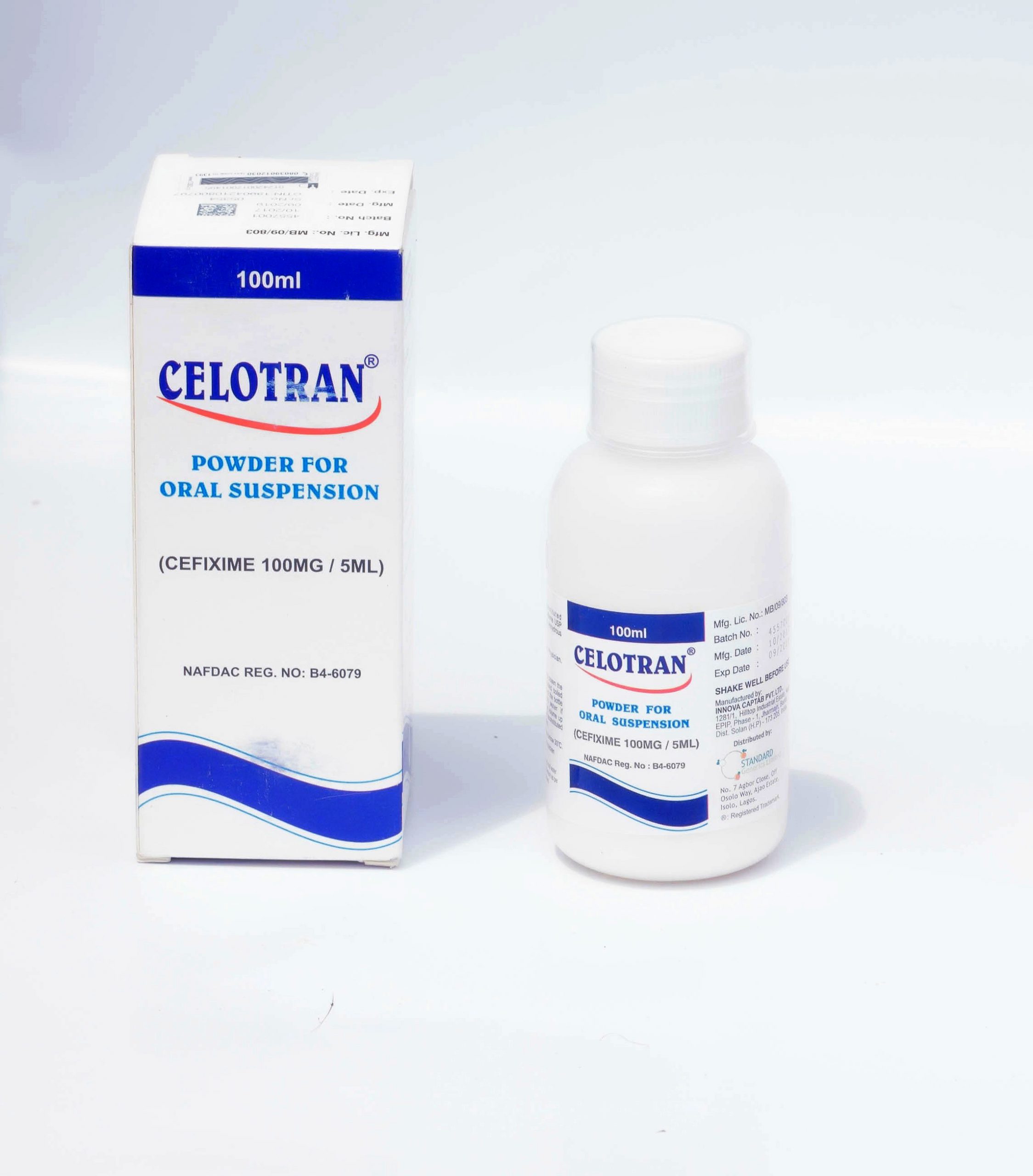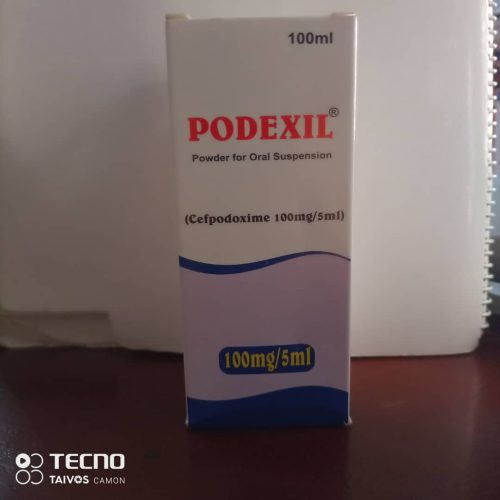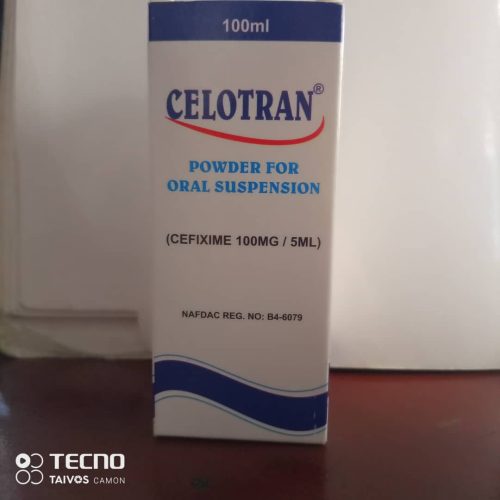Celotran
Use for the treatment of respiratory tract infections: e.g. bacterial pharyngitis, tonsillitis, otitis media, sinusitis and bronchitis as well as Urinary Tract Infections: e.g. acute cystitis and Uncomplicated gonorrhoea when caused by susceptible micro-organisms. Cefixime is contraindicated in patients with renal impairment with a creatinine clearance below 60 ml/min.
Dosage Form & Composition
Suspension: Each 5 mL of reconstituted Celotran (as trihydrate) USP equivalent to Anhydrous Cefixime 100 mg
Pack size: Available as dry powder for reconstitution in 100 mL bottle in a carton.
Indications
Celotran is indicated for the treatment of the following infections, when caused by susceptible micro-organisms,
1 .Upper Respiratory Tract Infections: e.g., bacterial pharyngitis, tonsillitis, otitis media, sinusitis.
2. Lower Respiratory Tract Infections: e.g., bronchitis.
3. Urinary Tract Infections: e.g., acute cystitis.
4. Uncomplicated gonorrhoea.
Contra-indications
Allergy to cephalosporins. Cefixime is contraindicated in patients with renal impairment with a creatinine clearance below 60 ml/min.
Precautions/Warnings
Use in pregnancy and breast feeding: Safe use in human pregnancy has not been established and it is not known whether Cefixime is excreted in human breast milk. Interactions: No significant interactions have been reported to date.
A false positive reaction for glucose in the urine may occur with Benedict’s or Fehling’s solution or with copper sulphate test tablets, but not with tests based on enzymatic glucose oxidase reactions.
A false positive direct Coombs test has been reported during treatment with cephalosporin antibiotics, therefore it should be recognised that a positive Coombs test may be due to the medicine.
WARNINGS:
Cefixime should be given with caution to patients who have shown hyper-sensitivity to other medicines, Cephalosporins should be given with caution to penicillin-sensitive patients as there is some evidence of partial cross allergenicity between the penicillins and the cephalosporins. Patients have had severe reactions (including anaphylaxis) to both classes of drugs.
If an allergic effect occurs with Cefixime the drug should be discontinued and the patient must be treated with appropriate agents if necessary. Cefixime should be administered with caution in patients with markedly impaired renal function (See “Dosage in Renal Impairment”)
Prolonged use of Cefixime may result in the overgrowth of non-susceptible organisms, Cefixime has been shown to alter the normal flora of the colon and may permit overgrowth of Clostridia, Studies indicate a toxin(s) produced by Clostridium difficile is the primary cause of antibiotic associated pseudomembranous colitis, The product should be discontinued if diarrhoea occurs.
Dosage & Administration
Absorption of Cefixime is not significantly modified by the presence of food. The usual course of treatment is 5 -14 days.
Adults and Children over 12 Years: The recommended adult dosage is 200 – 400 mg daily given either as a single dose or in divided doses.
In lower respiratory tract infections, 400 mg daily is recommended.
For upper respiratory tract infections and uncomplicated urinary tract infections, 200 mg once daily is usually effective.
For sinusitis the therapeutic dosage must be administered for 10 to 14 days.
Treatment of uncomplicated Gonorrhoea: The recommended dosage is 400 mg as a single oral dose.
Children: The recommended dosage for children is 8 mg/kg/day administered as a single dose or in two divided doses. As a general guide for prescribing in children the following daily doses in terms of volume of Oral Suspension are suggested:
| Patient Age | Dose/Day | Dose/Day |
| 6 months – 1 year | 75 mg | 3.75 mL |
| 1 – 4 years | 100 mg | 5 mL |
| 5 – 10 years | 200 mg | 10 mL |
Dosage in Renal Impairment: Cefixime may be administered in the presence of impaired renal function. Normal dose and schedule may be given in patients with creatinine clearance of 20 mL/min or greater.
In patients whose creatinine clearance is less than 20 mL/min, it is recommended that a dose of 200 mg once daily should not be exceeded. The dose and regimen for patients who are maintained on chronic ambulatory peritoneal dialysis or haemodialysis should follow the same recommendation as that for patients with creatinine clearance of less than 20 mL/min.
OVERDOSAGE AND ITS TREATMENT:
No specific antidote exists. Cefixime is not removed from the circulation in significant quantities by dialysis. Treatment should be symptomatic and supportive.






Reviews
There are no reviews yet.